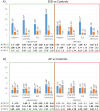Polygenic and Polyenvironment Interplay in Schizophrenia-Spectrum Disorder and Affective Psychosis; the EUGEI First Episode Study
- PMID: 39658350
- PMCID: PMC12414556
- DOI: 10.1093/schbul/sbae207
Polygenic and Polyenvironment Interplay in Schizophrenia-Spectrum Disorder and Affective Psychosis; the EUGEI First Episode Study
Abstract
Background: Multiple genetic and environmental risk factors play a role in the development of both schizophrenia-spectrum disorders and affective psychoses. How they act in combination is yet to be clarified.
Methods: We analyzed 573 first episode psychosis cases and 1005 controls, of European ancestry. Firstly, we tested whether the association of polygenic risk scores for schizophrenia, bipolar disorder, and depression (PRS-SZ, PRS-BD, and PRS-D) with schizophrenia-spectrum disorder and affective psychosis differed when participants were stratified by exposure to specific environmental factors. Secondly, regression models including each PRS and polyenvironmental measures, including migration, paternal age, childhood adversity and frequent cannabis use, were run to test potential polygenic by polyenvironment interactions.
Results: In schizophrenia-spectrum disorder vs controls comparison, PRS-SZ was the strongest genetic predictor, having a nominally larger effect in nonexposed to strong environmental factors such as frequent cannabis use (unexposed vs exposed OR 2.43 and 1.35, respectively) and childhood adversity (3.04 vs 1.74). In affective psychosis vs controls, the relative contribution of PRS-D appeared to be stronger in those exposed to environmental risk. No evidence of interaction was found between any PRS with polyenvironmental score.
Conclusions: Our study supports an independent role of genetic liability and polyenvironmental risk for psychosis, consistent with the liability threshold model. Whereas schizophrenia-spectrum disorders seem to be mostly associated with polygenic risk for schizophrenia, having an additive effect with well-replicated environmental factors, affective psychosis seems to be a product of cumulative environmental insults alongside a higher genetic liability for affective disorders.
Keywords: GxE interaction; affective psychosis; cannabis; childhood adversity; environmental risk factor; polygenic risk score; psychosis; schizophrenia-spectrum disorder.
© The Author(s) 2024. Published by Oxford University Press on behalf of the Maryland Psychiatric Research Center.
Figures

References
-
- Kendell RE, Gourlay J. The clinical distinction between the affective psychoses and schizophrenia. Br J Psychiatry. 1970;117:261–266. https://doi.org/ 10.1192/s0007125000193225 - DOI - PubMed
-
- World Health Organization & World Bank. WHO | World Report on Disability. World Health Organization; 2011. Accessed July 23, 2019. https://www.who.int/disabilities/world_report/2011/report/en/
-
- Hay SI, Abajobir AA, Abate KH, et al. Global, regional, and national disability-adjusted life-years (DALYs) for 333 diseases and injuries and healthy life expectancy (HALE) for 195 countries and territories, 1990-2016: a systematic analysis for the global burden of disease study 2016. Lancet. 2017;390:1260–1344. https://doi.org/ 10.1016/S0140-6736(17)32130-X - DOI - PMC - PubMed
-
- Gaudiano BA, Dalrymple KL, Zimmerman M. Prevalence and clinical characteristics of psychotic versus nonpsychotic major depression in a general psychiatric outpatient clinic. Depress Anxiety. 2009;26:54–64. https://doi.org/ 10.1002/da.20470 - DOI - PMC - PubMed
-
- Michalak EE, Yatham LN, Lam RW. Quality of life in bipolar disorder: a review of the literature. Health Qual Life Outcomes. 2005;3:72. https://doi.org/ 10.1186/1477-7525-3-72 - DOI - PMC - PubMed

